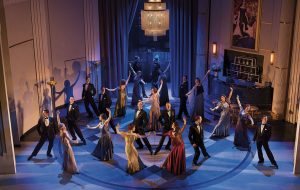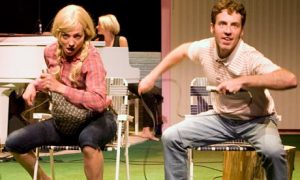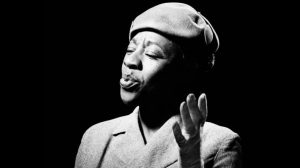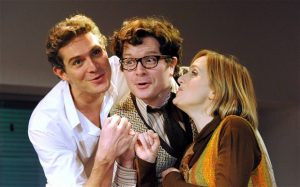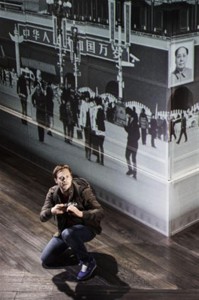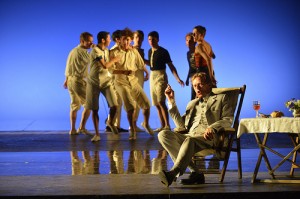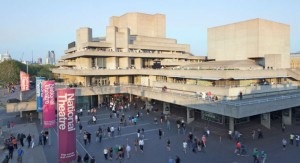A Theatre Holiday, Part 2 – London
The best thing about London theatre is that there is so much of it. There is commercial theatre, clustered in the West End around Leicester Square and Piccadilly Circus, there are several institutional theatre companies, most notably the National Theatre, which operates from expansive facilities on the south bank of the Thames, right at the Waterloo Bridge. And, there are theatre companies doing cutting edge work, often in venues that are off the beaten track.
I managed to see some of each of this sort of theatre during my recent London trip. The number of shows I could see in a week was heavily influenced by the fact that matinee performances occur most every day, not just Wednesdays, Saturdays, and Sundays, as is the common practice in the U. S. So, in seven days, I saw seven plays and two operas. I’ll discuss the plays first and then comment on the operas.
Commercial Theatre – West End
The West End houses productions that are intended for its houses as well as transfers from the National Theatre or from the smaller companies. There were some of each kind in the four West End productions I saw.
Productions created for the West End typically need commercial appeal and that appeal can be generated in a number of ways. The musical, Top Hat, for example, is based on the Fred Astaire/Ginger Rogers film of the same name. It features music by Irving Berlin, including standards such as “Top Hat, White Tie and Tails” and “Cheek to Cheek.” The commercial appeal is clearly the familiar dance styles and the score, though the cast features Gavin Lee (Mary Poppins) in the Astaire role (American actress Kristen Beth Williams plays the Rogers role). There’s a reworked book (the plot’s still lighter than air) and lavish sets and costumes, but clearly the appeal’s in the dancing. It’s the kind of show that is designed to run forever, and it just might.
The other approach is to cast well-known names, and the West End had a couple of doozies on while I was there. There was the famed director, Michael Grandage, who has mounted a star-studded season of five plays featuring well-known actors and with tickets as inexpensive as £10. The summer show was Martin McDonagh’s The Cripple of Inishmaan, and it featured Daniel Radcliffe, Harry Potter himself. Tickets were difficult to obtain if you didn’t buy ahead (or could commit to queuing for hours early on the day you wanted to see the show), but if you wanted to attract in a young audience to see quality theatre this strategy was a pretty terrific one for doing so.
The other theatre royalty in town was Dame Helen Mirren, the Oscar™ winner for playing Britain’s monarch, Elizabeth II, in “The Queen.” She was once again playing the queen, only this time in a play about the monarch’s weekly meetings with her prime ministers, titled The Audience. With direction by Billy Elliot’s Stephen Daldry and a crack supporting cast led by Richard McCabe extremely likeable performance as Harold Wilson, The Audience was the epitome of a grand West End commercial production, even if it may not have been a great play. You can see for yourself: the National Theatre Live series is presenting an HD broadcast version of The Audience in two local theatres: Saturday, June 29 and Sunday, June 30, 11am, at the La Jolla Village Cinemas; and Thursday, June 27, at 7pm, Sunday, June 30, at 2pm, and Tuesday, July 2, at 7pm, at the Gaslamp Stadium.
National Theatre
The National is a class operation, from its campus grandly arrayed on the south bank of the Thames to the quality of the work it presents and the prices of its tickets. You are nearly always going to be glad you patronized the company, even when you might not care for the show you saw.
Such was the case for the first of two productions I saw at the National: Mission Drift. Written and performed by The Team, a theatre collective consisting of young performers from the theatre programs at NYU and Yale, it had been the hit of last summer’s Edinburgh Festival. The show was billed as a musical, but I would call it a play with quite a bit of music, most of which was provided by Heather Christian and a band. Set in a Las Vegas that manages to remake itself following a variety of tragedies (nuclear tests, camp casino architecture, overbuilding/foreclosure) the themes nevertheless seemed shallow to me (a problem compounded by the fact that I didn’t “get” Ms. Christian’s music). The National staged it in its temporary black box space called The Shed. This space was less formal and less costly than other spaces in the complex and seemed design to attract in younger audiences , a goal that seemed to be met, at least in part.
The other production I saw was James Baldwin’s little-done The Amen Corner, at the company’s premier space, the Olivier Theatre. It was a solid production of a problematic play, one where Baldwin showed flashes of brilliance but also managed to muddy his portrayal of a storefront church dealing with a crisis of faith. Marianne Jean-Baptiste, as Sister Margaret, the charismatic but stiff-necked preacher, redeems the show with the complexity of her portrayal.
Two West End Transfers and One About to Transfer
Subsidized and smaller companies oftentimes come up with hit productions, and the West End accommodates some of the hits by providing a place to transfer. I saw two shows that had already transferred and one where a transfer was scheduled.
The biggest hit of the three was The Curious Incident of the Dog in the Night-Time, a National Theatre transfer for a summer run at the Apollo Theatre. This play both begins and ends with a dog on stage, and in between it tells the tale of a “special needs” boy (Luke Treadaway, alternating with Johnny Gibbon), who happens to be a wiz at math. Marianne Elliott (War Horse) directs a visually stunning, fast-paced, and emotionally satisfying drama about finding family.
Merrily We Roll Along, Stephen Sondheim’s best flop musical, has consistently puzzled those who have staged it. That’s why I was excited to see the Menier Chocolate Factory production, which was directed by Olivier-winning actress Maria Friedman. Word was that Ms. Friedman had solved many of the problems inherent in a show that tells its story backward, its characters going from being jaded and bitter to being idealistic and ready to conquer the world.
And she had, though in doing so she created others. Working with the current authorized version of the musical, Ms. Friedman managed to make a case for the vision put forward by Mr. Sondheim and his book author, George Furth. Interestingly, the theme Ms. Friedman found in Merrily was quite similar to the theme that Eric Schaeffer found in his production of Company, another Sondheim-Furth show: the impossibility of friendship.
To elaborate, I need to tell you key elements of Merrily’s story, only forward. It opens on the roof of a New York apartment, early in the morning. Two young men who don’t know each other well are just in the process of moving into the building as roommates. Franklin Shepard (Mark Umbers) is a graduate of Julliard, and he has ideas about setting the world of musical theatre on fire with his composition ability. Charley Kringas (Damian Humbley) is a recent Columbia grad who wants to write plays. Popping up to the roof in her pajamas is Mary Flynn (Jenna Russell), who wants to be a novelist and who has taken an entry-level editorial job at a magazine. Her roommate, Evelyn (Julie Jupp) also appears briefly but flees because she is embarrassed to be seen in her pajamas by men she doesn’t know.
The group has gone to the roof to spot Sputnik, the first space vehicle, fly over. It is the dawn of a new era, and Franklin, Charley, and Mary are all smart enough to know that. They pledge a vow of friendship (including inventing a hand-signal ritual for their relationship) on the spot.
Of course, what’s really gone on is that Charley and Mary have become bonded to Franklin, the one among them who is quite physically attractive and talented. Franklin, as apparently has been his pattern throughout life, is flattered by the attention of two other talented people, but he’s fooling himself when he calls them friends. Franklin’s pattern will be to respond but not commit to people who admire him – and these will include Beth (Clare Foster), who he will marry, father a child with, and then divorce in favor of Gussie (a very fine Josefina Gabrielle), a Broadway star who will leave her husband/mentor, Joe Josephson (Glyn Kerslake), for Franklin. Mary will nurture her secret, impossible, love for Franklin, and it will pull her into alcoholism despite publishing a well-reviewed novel. Charley will marry the unassuming Evelyn and have a family, write a Pulitzer Prize-winning play, but continue to be frustrated by Franklin’s lack of attention to their musical theatre projects. He will eventually explode the friendship on national television.
I do find it interesting that Ms. Friedman and Mr. Schaeffer, each on different sides of the Atlantic, have come up with a similar theme for two Sondheim/Furth shows (recall that in my earlier piece I said that Bobby in Company was the attractive one, bringing his glamor to his friends’ less-than-ideal married relationships – but at the same time falling into a trap of allowing his friends to tell him that he wasn’t ready to be married as a means of keeping him in their lives). Despite their similarities, the two shows are different and where Bobby can generate audience sympathy when he lets go of his married friends, Franklin comes off as a cad who has wrecked his friends’ lives. To soften this impact, Ms. Friedman makes Mary and Charley to be unsympathetic as well, a tactic that heightens the irony of the rooftop scene at the end (beginning) of the story at the expense of not having anyone for whom the audience can root. Sure, Franklin isn’t a great friend, but then no one else in the show is, either. To invoke a stereotype, British audiences may well take to this approach better than would Americans.
The show that is about to transfer is perhaps the most exciting one I saw on my entire trip. It is an important new play by Lucy Kirkwood titled Chimerica, and it’s making its world premiere at the Almeida Theatre. Some of Ms. Kirkwood’s other plays exhibit a fascination with media, and here her protagonist is a photojournalist (Stephen Campbell Moore) who took the iconic image of the young Chinese man waving down a tank in Tiananmen Square in June 1989. Joe, the photojournalist, has become obsessed with finding what happened to the man, and his quest takes him deep into New York’s Chinese immigrant community and well over the edge of journalistic ethics on more than one occasion. Lyndsey Turner’s production manages to be intimate and sweeping in one fell swoop, and the three hour, five minute, running time flies by, even if you are (as I was) seated with two posts between the stage and you. This production replaces Merrily We Roll Along at the Harold Pinter Theatre in August, and I certainly foresee productions in New York and beyond.
Two at the English National Opera
The ENO specializes in English language versions of operas, but the two I saw were both written in English. One was a new opera by Phillip Glass, titled The Perfect American. I was interested in seeing it despite fairly poor notices for the production because its subject was Walt Disney, a man whose contributions and legacy has recently been subject to examination in more-than-one theatrical performance. Mr. Glass’s opera made Disney a grotesque figure near death, and though I’m sure that most or all of his portrayal was accurate it was also not compelling to me as drama.
The following evening, however, I saw a very compelling production of Benjamin Britten’s final opera, Death in Venice. Britten is never an easy listen, and he deliberately composed the opera so that much of the singing would be done by the principal character, an aging man who becomes sexually obsessed with a young man he observes while on holiday in Venice. Tenor John Graham-Hall deserved the cheers he received at the curtain call for his marathon performance, but Edward Gardner’s sensitive and revealing conducting, Deborah Warner’s stage direction, and Tom Pye’s gorgeous set design helped to cement the ENO’s reputation as the most significant interpreter of Britten’s operas.
And Afterward…
Of course, it was difficult to settle back into life in San Diego after the trip, so when opportunities turned up to see Extraordinary Chambers at Mo’olelo Performing Arts and Neva at La Jolla Playhouse I jumped on them. Both productions exhibited the rich diversity of what San Diego theatre has to offer, and both assumed (rightly so) that audiences would be thoughtful and active participants in the experience (which also turned out to be the case). Extraordinary Chambers was notable for its cultural viewpoint, making audience members take into account how Cambodian life had (and had not) changed in the years since the U. S. -led war in Southeast Asia. Neva was notable for the Chekhovian longing, desire, and also independence exhibited by its three interrelated performers (Sue Cremin, Ramón De Ocampo, and Ruth Livier). It also made me highly aware of being self-taught (and having knowledge that is full of gaps) about this greatest of playwrights.
A Favorite Memory
Seeing sixteen performances in 14 days is not something I expect to do again for a while, and there were a number of wonderful memories associated with the trip. If I had to pick one, however, it would be from the last night I was in London. It was June 20, the eve of the summer solstice, and I was taking in the view of the Thames and central London from the outdoor patio of the National Theatre. Light breezes were blowing, and the soft summer light was extending long into the evening as the buildings along the river started to light up. Theatre may be magic, but sometimes theatres are in magical locations, and this was one of them.
Bravo!

